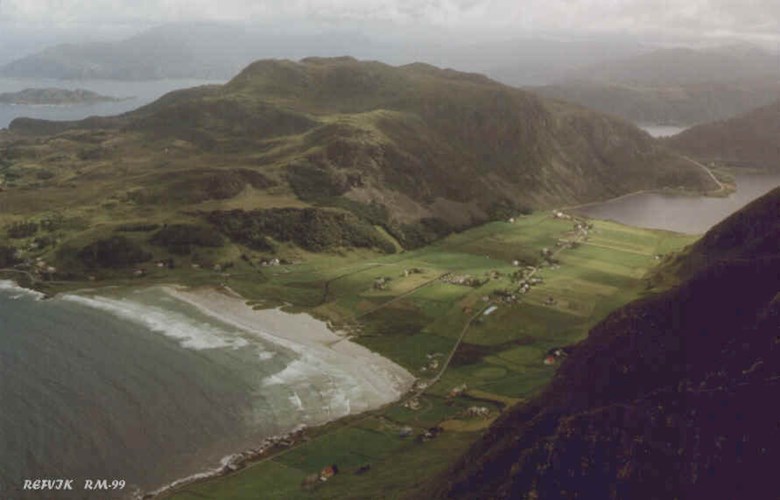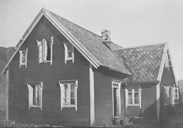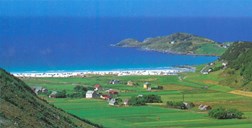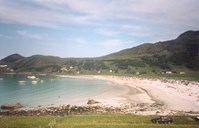22 August 1872
The village of Refvika is located between the beach of Refviksanden to the northwest and the lake of Refvikvatnet to the southeast. Up until 1872, all the houses on the farm were clustered together in the centre of the big, flat area between the beach and the lake. At that time some 100 people lived at the farm. On 22 August 1872, some small children played with fire in a barn, and they set fire to the hay. The fire led to newspaper headlines in most parts of the country.
"only a smoking heap of ashes"
In a Bergen newspaper the dean Fredrik Wilhelm Koren wrote the following: "On Thursday 22 August in the morning at 7.30, when most of the men had already left to go fishing in the ocean, some children were playing in a barn, and carelessly set fire to the hay. When they saw the fire, they became terrified and rushed out and hid. However, the fire spread rapidly from the barn and set the closest house on fire. The people in the house rushed out, and, risking their own lives, managed to save their small children. The fire leaped all the time from one house to the next, and with every new barn on fire, the column of smoke welled up into the sky. The smoke could be seen from a long distance, and the fishermen at sea also saw that something was wrong. They hurried home, only to find a smoking heap of ashes and weeping women and children. In a matter of four hours, 46 houses were completely destroyed and 113 persons had lost their homes and most of their belongings."
Dry timber houses and dry hay
The old timber houses had been dried by the summer sun. The haymaking season was over, and the barns were full of dry hay for the winter. The grain in the fields was turning yellow. All the hay harvest was destroyed at Refvika and much grain as well. A couple of days after the fire, an eyewitness writes: "women and children find shelter in boathouses and outlying barns, whereas men sleep out in the open on the burnt-out ruins still smoking. The cluster farmyard at Refvika was the reason why the fire having such exceptionally drastic consequences. Only one house and three barns were saved by tearing them down and moving them away from the fire.
Everybody helped
The reconstruction after the fire went quickly. The people of Refvika received much assistance. Only four days after the fire, the local council of the then municipality of Selje held a meeting. The council agreed that the people of Refvika needed immediate assistance in terms of food, clothes and shelter, and later help to build new houses. One person from each of the 23 school districts was appointed to collect money for the relief work. In addition, the council decided that all the farmers in the parish were to deliver about 40 kilos of hay before the winter set in. Money was raised everywhere. In Bergen, for example, a major money-raising effort took place. All this meant that the building of new houses could start much sooner.
New fire in 1914
After the fire in 1872, the farmers demanded a parcelling of land. The houses were then rebuilt approximately as we see the village today. This reduced the danger that this could happen once more. Nevertheless, this happened, but on a smaller scale. One night in March 1914, a box of peat in the kitchen of one of the farms caught fire. At that time they used mostly peat for heating and cooking. Perhaps some ember from the stove had ended up in the peat box. The fire spread quickly, and the residence, the barn and the cowshed on this farm burned down. The men were away fishing, but two women and a 14-year-old girl managed to get out all the domestic animals. All the houses were completely destroyed, but also this time the houses were quickly rebuilt.
The beach of Refviksanden
The beach of Refviksanden is almost 700 metres long, close to 100 metres wide and the sand is white as chalk. In 1988, the Norwegian paper Dagbladet selected Refviksanden as the finest beach in Norway. The water is shallow, which makes it ideal for families with small children. On sunny days, most of the beach is occupied by happy sunbathers and swimmers. However, the weather can be rough at Refvika. Most houses have 1-2-metre-thick walls as a protection against southeasterly winds. Strangely enough, it is not the storms from the ocean that cause most damage. It is rather the strong easterly fall winds descending in gusts between the high mountains down to the valley floor and shore.





